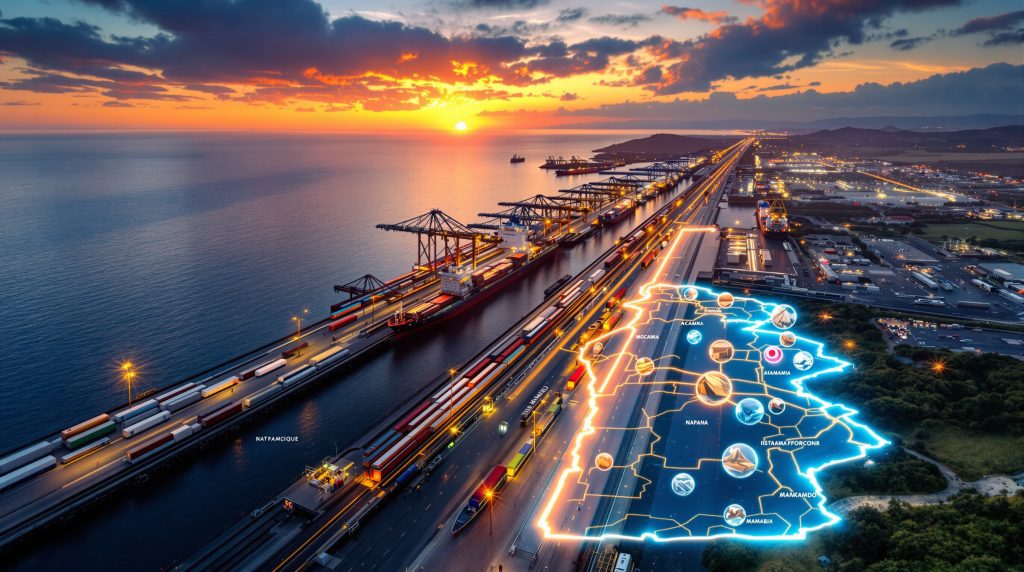Japan's Investment in the Nacala Corridor: Strategic Development and Economic Impact
The Nacala Corridor represents one of Africa's most strategic transportation networks, spanning across three nations—Mozambique, Malawi, and Zambia. This multimodal infrastructure corridor includes railways, roads, and the deepwater port of Nacala in Mozambique, which stands as the deepest natural harbor in Southern Africa, capable of accommodating large cargo vessels.
The corridor's significance stems from its role as a vital economic artery that facilitates the movement of agricultural products, minerals, and manufactured goods from landlocked countries to international markets. For resource-rich but landlocked Malawi and Zambia, the corridor provides the most efficient export route to global markets, substantially reducing transportation costs and time compared to alternative routes.
How Much is Japan Investing in the Nacala Corridor?
Japan has committed an unprecedented US$7 billion investment package to develop and enhance the Nacala Logistics Corridor. This substantial funding is structured as:
- US$5.5 billion in partnership with the African Development Bank
- US$1.5 billion in impact investment through Japan's development agencies
This investment represents one of Japan's largest infrastructure commitments in Africa and signals a significant shift in Japan's strategic approach to securing critical minerals security and strengthening economic ties with African nations. The program, officially titled "Strengthening Global Supply Chain through Nacala Corridor Development," was announced at the Tokyo International Conference on African Development.
Why is Japan Investing in African Infrastructure?
Strategic Resource Security
Japan's investment in the Nacala Corridor aligns with its national strategy to secure reliable access to critical minerals essential for its high-tech manufacturing industries. As a resource-poor nation heavily dependent on imports, Japan faces increasing competition from other nations for access to:
- Titanium (used in aerospace and medical applications)
- Graphite (essential for battery production)
- Rare earth elements (crucial for electronics manufacturing)
- Copper and cobalt (vital for electric vehicle production)
The corridor provides access to regions rich in these resources, particularly in Malawi and Zambia, offering Japan a more diversified supply chain and strategic resource security.
Economic Diplomacy and Influence
Japan's investment represents a strategic approach to economic diplomacy in Africa. Through this significant financial commitment, Japan aims to:
- Strengthen diplomatic relations with African nations
- Create opportunities for Japanese corporations in emerging African markets
- Establish long-term economic partnerships based on mutual benefit
- Promote Japan's development model emphasizing quality infrastructure and sustainable growth
Energy Security Considerations
Beyond minerals, Japan has significant interests in Mozambique's emerging liquefied natural gas (LNG) industry. Japanese corporations have invested heavily in Mozambique's LNG projects, and the Nacala Corridor provides critical infrastructure for supporting these energy developments.
What Specific Improvements Will the Investment Fund?
Transportation Infrastructure Upgrades
The US$7 billion investment program focuses on several key infrastructure enhancements:
- Railway Capacity Expansion: Increasing the freight capacity of the existing rail network to accommodate growing mineral exports
- Track Refurbishment: Replacing deteriorated sections of track and upgrading signaling systems to improve safety and reliability
- Rolling Stock Acquisition: Purchasing additional locomotives and freight cars to increase transportation capacity
Port Development
- Nacala Port Modernization: Expanding container handling facilities, bulk cargo terminals, and storage areas
- Loading/Unloading Efficiency: Installing modern cargo handling equipment to reduce vessel turnaround times
- Port Depth Maintenance: Ensuring the port's natural depth advantage is preserved through regular maintenance operations
Resilience Measures
- Climate Adaptation Infrastructure: Reinforcing vulnerable sections against extreme weather events, particularly cyclones that have previously damaged corridor infrastructure
- Redundancy Systems: Creating backup power and communications systems to maintain operations during disruptions
- Flood Control Measures: Implementing drainage improvements and protective structures in flood-prone areas
How Will This Investment Benefit Regional Economies?
Malawi's Economic Opportunities
For Malawi, the corridor improvements directly support the development of major mineral projects, particularly the Kasiya Rutile-Graphite Project. This world-class deposit contains:
- The world's largest rutile (titanium dioxide) resource
- Significant graphite deposits critical for battery metals investment
The enhanced corridor will reduce transportation costs significantly, making these mineral resources more competitive in global markets and potentially transforming Malawi's export economy.
Mozambique's Strategic Advantages
As the corridor's terminal point, Mozambique stands to benefit from:
- Increased port utilization and associated revenue
- Development of value-added services and logistics industries
- Growth in transit trade from neighboring countries
- Strengthened position as a regional transportation hub
The investment also supports Mozambique's vision to become a regional energy center, leveraging its natural gas resources and strategic location.
Zambia's Export Potential
For copper-rich Zambia, the corridor provides:
- A more efficient alternative to congested southern routes
- Reduced transportation costs for mineral exports
- Potential for increased agricultural exports
- Improved import logistics for essential goods
What Role Does the Kasiya Project Play in This Development?
The Kasiya Rutile-Graphite Project in Malawi represents a perfect case study of how the Nacala Corridor investment directly supports critical mineral development. As one of the world's largest undeveloped rutile and graphite resources, Kasiya's development is intrinsically linked to the corridor's capacity and efficiency.
Strategic Alignment with Japanese Markets
Kasiya's natural rutile has been technically validated by Toho Titanium Company Ltd as suitable for high-performance titanium metal production, creating a direct market connection to Japanese industrial consumers. This technical validation establishes a clear supply chain from Malawi to Japan's advanced manufacturing sector.
According to Sovereign Metals CEO Frank Eagar, "Japan's commitment to the Nacala Corridor infrastructure validates our strategic positioning and creates powerful opportunities for Kasiya's development." This statement highlights how the initiative demonstrates high-level government backing for the corridor that underpins the project's economics.
Logistics Integration
The project's development plans include:
- A six-kilometer rail spur connecting the processing plant directly to the Nacala Corridor
- Dedicated mineral handling facilities
- Integrated logistics systems designed to maximize efficiency
Economic Impact Potential
At full production, the Kasiya project could:
- Become one of Malawi's largest foreign exchange earners
- Create thousands of direct and indirect jobs
- Establish Malawi as a significant player in global titanium and graphite markets
- Generate substantial tax revenue for national development
How Does This Investment Compare to Other Infrastructure Development Approaches?
Japan's US$7 billion commitment to the Nacala Corridor represents a distinct approach to African infrastructure development compared to other international investment models.
Contrasting Approaches
| Aspect | Japan's Nacala Corridor Approach | Traditional Development Approach |
|---|---|---|
| Financing Structure | Emphasis on partnerships with multilateral institutions like the African Development Bank | Greater reliance on bilateral loans and state bank financing |
| Labor Practices | Focus on local employment and skills transfer | Often involves significant foreign labor importation |
| Environmental Standards | Higher emphasis on environmental impact assessments and mitigation | Variable environmental standards depending on project |
| Technology Transfer | Greater emphasis on knowledge sharing and capacity building | More limited technology transfer in some projects |
| Debt Terms | Generally more favorable and transparent loan terms | Some projects have led to debt sustainability concerns |
Strategic Positioning
The investment represents Japan's most significant infrastructure investment in Southern Africa, potentially creating a more balanced competitive environment for infrastructure development across the continent.
What Are the Environmental and Social Considerations?
Japan's investment approach typically emphasizes sustainable development principles, with several key environmental and social elements incorporated into the Nacala Corridor development:
Environmental Safeguards
- Comprehensive environmental impact assessments for all major infrastructure components
- Climate resilience measures to protect against increasing severe weather events
- Biodiversity protection in sensitive areas along the corridor
- Reduced carbon emissions through rail transportation compared to road alternatives
Social Development Components
- Local employment prioritization during construction and operation phases
- Skills development programs for corridor communities
- Support for small and medium enterprises along the corridor
- Community infrastructure improvements in areas adjacent to major developments
What Challenges Could Affect Implementation?
Despite its potential, several significant challenges could impact the successful implementation of the Nacala Corridor development:
Security Concerns
Parts of northern Mozambique have experienced insurgent activity, which could potentially affect construction timelines and operational security if the situation deteriorates or expands to corridor regions.
Coordination Complexities
The multi-country nature of the corridor requires complex coordination between the governments of Mozambique, Malawi, and Zambia, potentially leading to implementation delays if agreements on specific aspects cannot be reached promptly.
Capacity Constraints
Local institutional capacity to manage large-scale infrastructure projects may be limited, potentially affecting implementation efficiency and long-term maintenance capabilities.
Climate Vulnerabilities
The corridor region has experienced severe weather events, including cyclones that have previously damaged infrastructure. Climate change may increase these risks despite resilience measures.
What is the Expected Timeline for Development?
The US$7 billion investment program is expected to follow a phased implementation approach:
Phase 1 (Initial Stage)
- Critical repairs and immediate capacity enhancements
- Port modernization initiation
- Preliminary resilience upgrades in vulnerable sections
Phase 2 (Expansion Stage)
- Major railway capacity expansion
- Complete port modernization
- Comprehensive resilience measures implementation
Phase 3 (Optimization Stage)
- Advanced systems integration
- Technology upgrades
- Final capacity optimizations
How Will This Impact Global Supply Chains?
The development of the Nacala Corridor could significantly reshape certain global supply chains, particularly for critical minerals:
Titanium Supply Diversification
With Kasiya potentially becoming one of the world's largest rutile producers, the corridor could help diversify global titanium supply chains away from current dominant sources in Australia, Sierra Leone, and Kenya.
Graphite Market Transformation
The corridor could enable non-Chinese graphite sources to become more competitive in global markets, potentially reducing the current Chinese dominance in graphite production.
Regional Agricultural Exports
Improved logistics could make regional agricultural products more competitive in international markets, potentially transforming food supply chains from Southern Africa to global markets.
What Are the Investment Implications?
Japan's investment in the Nacala Corridor creates several potential investment implications:
Direct Investment Opportunities
- Infrastructure construction and management companies
- Logistics service providers specializing in mineral transportation
- Port operations and services
- Mining projects along the corridor, particularly those with Japanese plans to beef up key transport corridor
Secondary Market Effects
- Potential appreciation of mineral assets in the corridor's catchment area
- Increased competitiveness of agricultural exports from the region
- Development of supporting industries and services along the corridor
- Possible property value increases in key logistics nodes
Long-term Strategic Positioning
For investors with a long-term horizon, the corridor development represents a strategic positioning opportunity in a region that could become increasingly important for mineral beneficiation opportunities and mining industry evolution in the coming decades.
FAQ: Japan's Investment in the Nacala Corridor
How will Japan's investment in the Nacala Corridor affect mineral prices globally?
The improved logistics efficiency could potentially lower production costs for minerals like rutile and graphite from the region, making them more competitive in global markets. This might exert downward pressure on prices for these commodities if significant new supply enters the market. However, growing demand for these materials in clean energy technologies and advanced manufacturing may offset some of this price impact.
Will local communities benefit from this massive infrastructure investment?
Yes, local communities are expected to benefit through job creation, improved transportation access, and economic development opportunities. The investment includes specific social development components designed to ensure benefits reach corridor communities. However, the extent of these benefits will depend on effective implementation of community engagement programs and local content policies.
How does this investment affect international relations in Africa?
This investment represents a significant economic engagement approach in Africa. While not explicitly positioned as a counterbalance to other nations' influence, it effectively creates an alternative development model and partnership approach for African nations. This could intensify economic competition between major powers in strategic mineral-rich regions of Africa.
What happens if mineral prices decline before the corridor is completed?
The corridor's economic viability is not tied exclusively to any single commodity price, as it serves multiple industries including agriculture, manufacturing, and various mineral sectors. This diversification provides some resilience against commodity price fluctuations. Additionally, the strategic nature of the investment for Japan means that short-term price movements are less likely to affect long-term commitment to the project.
Could political changes in the region affect the implementation of this investment?
Yes, political stability remains a key risk factor. Changes in government or policy direction in any of the three countries involved could potentially affect implementation timelines or specific aspects of the development. However, the multilateral nature of the investment, involving the African Development Bank and Japan's transport corridor initiatives, provides some institutional stability that may help mitigate political risks and ensure rail haulage improvements continue as planned.
Looking to Profit from the Next Major Mineral Discovery?
Stay ahead of the market with Discovery Alert's proprietary Discovery IQ model that delivers real-time notifications on significant ASX mineral discoveries, turning complex data into actionable investment opportunities. Explore how historic discoveries have generated substantial returns by visiting the Discovery Alert discoveries page and begin your 30-day free trial today.




